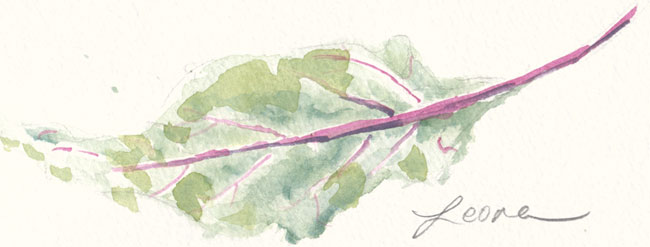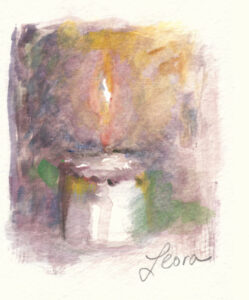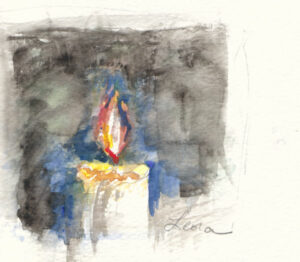

Yesterday this painting, “Contemplating a Stream”, made its debut on the blog of A Simple Jew. Today I will tell you a bit more about the painting. It is a copy of a watercolor by John Singer Sargent, one of the great masters of watercolor. Next week another watercolor will be shown, that one a copy of a painting by another great American watercolorist, Winslow Homer.
One of the best ways to learn art is to copy great artists. That is why in the 19th century so many Americans went to Europe. Nowadays, we have reproductions in books and online. By copying both of these painters, I learned so much about how to describe water with paint. I hope I can use some of my talents toward making a watercolor of one of my canoe photographs.
Click on the painting to see it enlarged.
What do you suppose the man is thinking?
 Read this post to find out why I chose this man by the water theme.
Read this post to find out why I chose this man by the water theme.

In many public places in Israel one can find art. Above is a detail of a mosaic at Rosh Hanikra.


Even mailboxes (at left, mailbox in Tsefat) and utility boxes (at right, in Jerusalem) are often decorated with beautiful, colorful paintings.


We were introduced to the art of Sol Baskin at the military museum in Latrun. I believe the large painting at the bottom is of the Six Day War.

Ginosar, a resort on the Kinneret, has a sculpture garden. And too much green grass, considering water is in short supply in Israel.

The above realistic mural is on a building on Rechov Yaffo, Jaffa Street in Jerusalem. Depicted is the light rail train that is under construction and will run in the city.

There are some wonderful art museums in Israel (Tel Aviv Museum, Israel Museum), but we didn’t get a chance to visit these on our recent trip. We did, however, go into the above building, which is the original building for the Bezalel School of Art. It now has art exhibits on each floor of the building.
Art fans: please visit A Simple Jew today for a little treat. I’m planning to post the painting here on my blog tomorrow.
This was sort of like an art challenge, similar to the photo challenges one finds on blogs. It started with his asking me to write something, but I wanted to paint something.
Here’s a quote he sent to me as a suggestion:
The Degel Machaneh Ephraim taught that a person must have two abilities if he wants to be able to serve Hashem in absolute truth and sincerity. First, a person must have the ability to visualize that he is alone in the world with only his Creator. Second, he must be able to join himself to all of Hashem’s creations, no matter how big or small, and to all the neshamos of His people.
I wasn’t quite sure what to do with this, but after a few emails, we came up with the idea of a man in a forest near a stream contemplating. Another watercolor will be posted next week.
My Middle Son and I are going to be in an art show at the Highland Park Public Library in September 2008. You are all most cordially invited to attend the opening on Sunday, September 7 from 2-5 pm (did I just invite way too many people, Jill?).
It is a showing of the art students of Jill Caporlingua. As I am the webmaster for the library’s site, I added some of art that will be on display to the library gallery.
Here’s a piece I chose to be in the show; not one I did with Jill, but it is my favorite oil painting:

I’m afraid this image doesn’t do the painting justice; it’s much nicer to view in person, especially when the subject himself is sitting right under the painting, buried in one of his books.
I am also planning to show:
this garden watercolor
and
this portrait.

I did this watercolor in honor of my beets giver…who gave understanding and connection at a difficult time.

I got inspired by your comments on my last post of candles, and I did two more. More struggling. One of the hard parts about watercolor is that once you add the color, you can’t have the white of the canvas anymore. And it’s easy to work the painting too much. So I cheated on the painting above. I used Photoshop to add some white. Why do I confess? Part of blogging is to share my feelings and issues. Can anyone else get frustration? Like you are close to a goal, but then you mess up, once again. Well, not completely mess up, but not quite get it the way you want it to be, either.

On the last post, Ilana-Davita suggested the varied colors added to a less pessimistic painting. However, at the same time, it is not supposed to be a birthday party candle, so I don’t want to make it too festive. I went to the dentist yesterday (Dr. Ira Feldman in East Brunswick, a wonderful man and good dentist, too), and he has this fascinating painting on his office wall that has purple shadows. So I thought, instead of black, maybe I should make the shadows of my yahrzeit candle purple?
Feel free to tell me anything you want about my little candles. Thank you so much for looking!
I needed to send someone a condolence card. Someone who sat shiva (one sits shiva for seven days for a close relative, in this case a brother) far away. So I painted two watercolors of yahrzeit candles. I’ve never painted lit candles before, and it wasn’t easy. I chose one to send. Here are both the watercolors:



Another Photoshopped photo. I do hope these women don’t recognize themselves. I used so many different Photoshop tools: brush, clone stamp, palette knife, colored pencil filter, sponge, desaturate, paint daubs, magic wand.

Spider plant outside window of my friends’ home in Hashmonaim, ink pen on paper, tweaked with some color in Photoshop

Same spider plant drawing, ink pen on paper, before any color additions




















